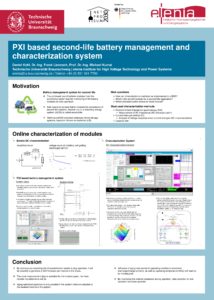Summary:
Cost efficient stationary energy storage systems can be produced when battery modules from the automotive application are reused. Batteries from electric vehicles are mostly returned from the first life usage when they reach a capacity of 80 percent of its nominal capacity. To guarantee an intrinsic safe operation of the second life system a battery management system (bms) is needed. Compared to automotive bms the assembly space is not strictly limited and extra functions can be implemented. The implementation of characterization algorithms can help to record and track the ageing processes of the modules. One method is the current interrupt method where a current pulse is applied to the module. The internal resistance can then be calculated with the applied current and the voltage response of the module. This can be done during the operation of the system or by integrating a testing circuit for each module in the bms. By using the testing circuit, it is additionally possible to balance the battery modules. Balancing of modules is important when the soh of the modules differ significantly. By using reference data, the modules can be classified. For the integration in the bms the software has to be extended with the reference data and a characterization functionality. Based on the used battery modules and the knowledge of the ageing data it is possible to apply charge and discharge profiles to limit aging mechanisms. This can increase the lifetime and security of the second life system.
We are happy to forward your request / feedback.

